<Note to Self: Many of the rules below will be affected by Combat Driver and Combat Pilot skill once they are more fully developed.>
Vehicle Movement Table |
Meters/Turn | KPH | MPH |
5 | 3 | 2 |
10 | 6 | 4 |
20 | 12 | 8 |
30 | 18 | 11 |
40 | 24 | 15 |
50 | 30 | 19 |
60 | 36 | 23 |
70 | 42 | 26 |
80 | 48 | 30 |
90 | 54 | 34 |
100 | 60 | 38 |
125 | 75 | 47 |
150 | 90 | 56 |
175 | 105 | 66 |
200 | 120 | 75 |
250 | 150 | 94 |
300 | 180 | 112 |
350 | 210 | 131 |
Acceleration
A driver can increase the speed of his vehicle at the start of every game turn. To do this, the player decides how much faster he wants to move, and adds this number of meters/turn to his current speed. There is a limit to how much a vehicle's speed can be increased in one turn. This limit is the vehicle's acceleration rate. The Vehicle Data Table shows acceleration rates for all the ground vehicles in meters/ turn.
EXAMPLE: During its last move, a skimmer traveled 40 meters/ turn. Its acceleration rate is 80 meters/ turn. At the beginning of its next move, the driver of the skimmer can increase its speed to 120 meters/turn (40 + 80 = 120).
Deceleration
A driver can slow down his vehicle at the start of each game turn. To do this, he subtracts the amount he is decelerating from his current speed; the result is his speed for this turn. lf the result is 0, the vehicle has stopped and it does not move this turn. The amount a vehicle can slow down in one turn is limited by its deceleration rate. Deceleration rates for ground vehicles are shown on the Vehicle Data Table.
Emergency Stopping
A vehicle can come to a complete stop from any speed in one turn by making an emergency stop. The vehicle moves one-half of its starting speed. At the end of the turn its speed is 0. The driver must make a Reaction Speed check to keep the vehicle under control. If he fails the check, he loses control; see Crashes, below.
Maximum Speed
No matter what its acceleration is, a vehicle can not move faster than its maximum speed. Maximum speeds are listed on the Vehicle Data Table.
Backing Up
A vehicle can drive backward at up to 50 meters/turn. A vehicle that is moving forward must come to a complete stop before moving in reverse. A vehicle's acceleration rate in reverse is one-half its normal acceleration.
Turn Speed
The Vehicle Data Table shows turn speeds for the ground vehicles. A vehicle can turn 45 degrees to the right or left in every 5-meter square it enters if its speed in meters/turn is equal to or less than its turn speed. If the vehicle is traveling faster than its turn speed, it must move straight at least 10 meters after making a 45 degree turn before it can turn again. This information is summarized on the table below. See the diagram for examples.
- For a vehicle traveling at Turn Speed or less, distance between turns is 5 meters.
- For a vehicle traveling at greater than Turn Speed, distance between turns is 10 meters.
Straight movement from the previous turn can be counted toward these requirements. A driver can turn a vehicle more sharply than indicated above, but risks losing control or crashing; see Short Corners.
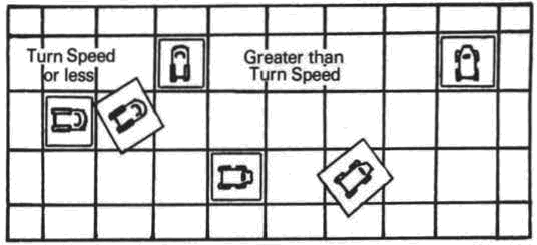
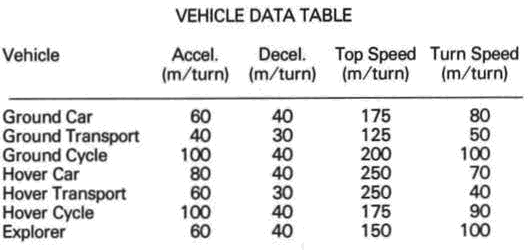
Special Maneuvers
Besides driving straight and turning corners, vehicles, can perform special maneuvers. These include slips, pivots, skid turns, bumps and stunts.
Slipping
Slipping is similar to "changing lanes"; it allows a vehicle to swerve to the right or left without changing its direction of travel. Any type of vehicle can slip. A slipping vehicle moves 10 meters ahead and 5 meters to either side. This counts as only 10 meters of movement. A vehicle can not turn while slipping. A vehicle can slip once for every 10 meters it moves.
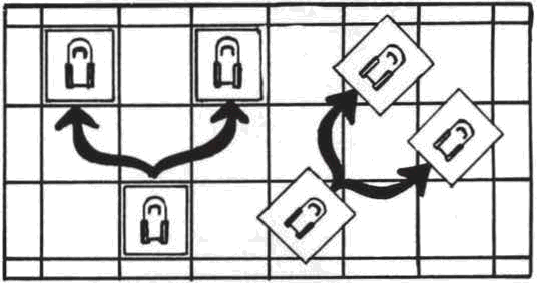
Pivot
A pivot is a turn of up to 360 degrees performed in one spot. Only hover vehicles and Explorers can pivot. A vehicle must be stationary at the beginning of the turn to pivot. The pivoting vehicle stays in the same square, and the driver can rotate it so it points in any direction.
Skid Turns
A skid turn is done by slamming on the brakes while turning so the vehicle skids around 1 80 degrees. Only ground cars, ground cycles and Explorers can perform skid turns. The vehicle must be traveling from 60 to 80 meters/turn. It actually will move only 20 meters during the turn, and have a speed of 0 at the start of the next turn.

The driver of the vehicle rolls percentile dice. If the result is less than or equal to his Reaction Speed, the driver performs the skid turn safely. If the result is higher than the driver's Reaction Speed, the vehicle will point in a random direction when it stops skidding. When this happens, move the vehicle as if it had skidded successfully. Now roll 1d10 and turn the vehicle 45 degrees clockwise a number of times equal to the number rolled.
Bumping
A driver can try to make another vehicle crash by bumping it. In order to bump, the driver or his team must have initiative for the turn. The driver must slip directly in front of the other vehicle. Both drivers then make Reaction Speed checks. The driver who performed the slip makes a normal check, but the driver whose vehicle was bumped has a modifier of -15. If either driver fails the check. he loses control of his vehicle (see Crashes).
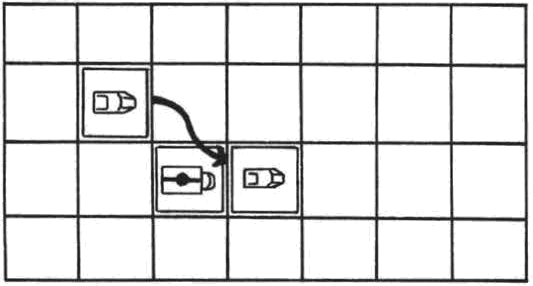
Stunts
Drivers can perform other stunts, such as jumping their vehicles over bridges, at the referee's discretion. Things to consider when setting up a stunt are the type of vehicle being used, the amount of open space the vehicle has to work with, and the vehicle's condition and cargo.
Short Corners
A driver can try to turn his vehicle tighter than its speed allows, but risks losing control of the vehicle and crashing.
A driver shortens a corner if he tries to turn 5 meters before he should. For example, a ground cycle has a turning speed of 100 meters/ turn. If the cycle is traveling 150 meters/ turn, it must travel straight 10 meters after making a turn before it can turn again. lf the driver tries to make the second 45 degree turn after traveling straight only 5 meters, he is shortening the corner by 5 meters.
Whenever a driver shortens a corner, the player must roll d100. If the result is less than or equal to the driver's Reaction Speed, the driver makes the turn safely. lf the result is higher than the driver's Reaction Speed, the driver loses control during the turn (see Crashes).
Crashes
Losing Control
When a driver loses control of his vehicle, the player must roll d100 and check the Control Table to see what happens to his vehicle. The die roll is modified by adding the vehicle's speed in meters/ turn to the result.
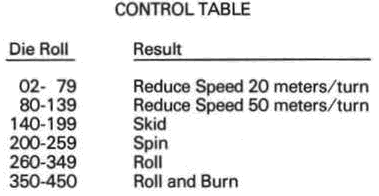
Explanation of Results
- REDUCE SPEED. The vehicle immediately reduces its speed by the indicated amount. If this is more than half of the vehicle's current speed, the vehicle slows down to one-half its current speed. The vehicle finishes the move at this new speed.
- SKID. The vehicle is skidding out of control. Divide its speed in meters per turn by 10, rounding fractions up. Move the vehicle this number of meters in the direction it was moving before it went out of control. If the vehicle skids into a building or other obstacle, treat it as a collision (see Collisions). Otherwise, the vehicle continues moving from its new position.
- SPIN. The vehicle is skidding out of control and spinning. Divide its remaining movement by two. Move it that many meters in the direction it was traveling before it started skidding. Now roll 1d10 and turn the vehicle 45 degrees clockwise a number of times equal to the number on the die. On the next turn the vehicle will skid to a stop. Move it one-half of its speed in the direction it was traveling before it went out of control and roll 1d10 again to determine how much it spins.
- ROLL. The vehicle is rolling out of control. Treat this the same as a spin, but do not roll 1d10 to determine the vehicle's facing. Instead, each passenger in the vehicle suffers 1d10 points of damage. When the vehicle stops rolling, roll 1d10; if the result is 1, 2 or 3, the vehicle is right-side-up. Otherwise it is on its side or top. The vehicle will run again in 1d10 turns if it was traveling at its turn speed or less.
- ROLL AND BURN. This is the same as a roll, but the vehicle is burning also. Each passenger suffers an additional 1d10 damage from the fire at the start of each turn he is in the vehicle. A character can get out of the vehicle in one turn if it has stopped rolling. If a character tries to get out of the vehicle while it is rolling, he must make a Reaction Speed check. If he passes the check, he has escaped from the vehicle. If he fa ils the check, he has not gotten away from the vehicle and he suffers an additional 1d10 damage immediately.
Collisions
If a moving vehicle hits a building, rock, other vehicle or obstacle of any type, it has had a collision. The vehicle stops moving immediately.
Damage to Vehicles
If the vehicle was traveling faster than its turn speed, it will not run again without extensive repairs. If the vehicle was traveling at its turn speed or slower, it can be driven again after 1d10 turns. However, its acceleration and turn speed are reduced by 20 meters/turn.
Injury to Passengers
When a vehicle crashes, divide its speed in meters/turn by 20, rounding fractions down. The result is the number of d10 that are rolled to determine how many points of damage each character takes. Add 2 points to each die result if the character was riding a ground or hover cycle, and subtract 2 from each die if the character was riding in an Explorer (no die roll can be modified below 0). This information Is summarized on the table below.

Crashing Through Obstacles
If characters tries to drive through a barricade or obstacle, the referee must use his discretion to decide how badly the vehicle is damaged, whether it keeps running, and whether the passengers are hurt. A vehicle may be able to smash through obstacles that are less solid than concrete posts or parked vehicles.
Vehicle Combat
This combat section covers only personal weapons fired from or at vehicles. Vehicle-mounted weapons are not covered in this set of rules.
Firing From Vehicles
A character who fires a weapon from a moving vehicle has a -10 modifier to hit. If the vehicle is moving faster than 150 meters/turn, the modifier is -20.
Shooting At Passengers
A character can shoot at a passenger inside a vehicle. There is a -20 modifier because the passenger has hard cover, and a -10 modifier if the vehicle is moving. Needlers can injure passengers only if the vehicle's windows or top are open.
Firing At Vehicles
If a character fires a weapon at a moving vehicle, he has a -10 modifier to hit. This modifier does not apply if the vehicle is moving directly toward or directly away from the firing character. Needlers and gas grenades have no effect on vehicles.
Damaging Vehicles
Whenever a vehicle is hit by gunfire, an exploding grenade or a thrown explosive, the attacking character must roll 2d10 on the Vehicle Damage Table. The number of dice of damage caused by the attack is added to the result. This number is modified by the type of vehicle. A separate roll is made for each successful attack.
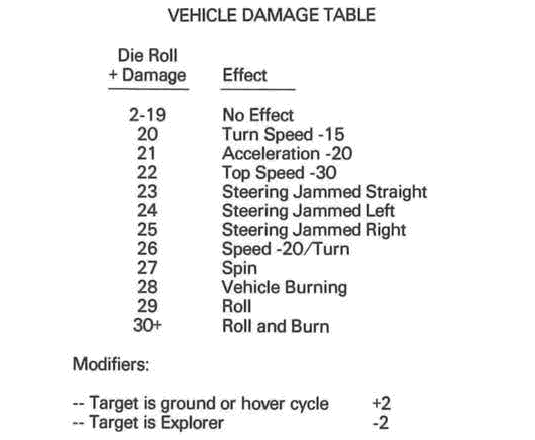
Explanation Of Results
- TURN SPEED -15/ACCELERATION -20/TOP SPEED -30. The vehicle's turn speed, acceleration or top speed is reduced by the indicated number of meters/turn.
- STEERING JAMMED STRAIGHT/LEFT/RIGHT. The vehicle's steering mechanism has been jammed. If straight, the vehicle can not turn. If right or left, the vehicle must turn 45 degrees in the indicated direction after each 20 meters of travel. For example, a skimmer traveling at 80 meters/turn with its controls jammed in a right turn must turn 45 degrees to the right after traveling 20, 40, 60 and 80 meters during its next move. The skimmer can decelerate or accelerate, but can not change its direction.
- SPEED -20/TURN. The vehicle must reduce its speed at least 20 meters/turn until it is stopped. It can decelerate more than this if the driver wants, but it can not accelerate.
- SPIN. See Control Table results.
- VEHICLE BURNING. The vehicle has caught fire. Each passenger will suffer 1 d1 0 points of damage at the start of every turn they are in the vehicle.
- ROLL. See Control Table results.
- ROLL AND BURN. See Control Table results.
Example: BliCiuet the Dralasite is shooting its laser pistol at a street punk that has just stolen BliCiuet's hover cycle. Its Dexterity is modified by -10 because the target is a moving vehicle, and by -20 because the cycle is at medium range. BliCiuet has a modified Dexterity of 15 for this shot. One of its two shots hits the cycle. BliCiuet had the laser set for 7d10 damage. The player rolls 2d10 and gets a 16. Adding 7 for the damage and 2 because the target was a cycle gives a modified result of 25; the cycle's steering is jammed to the right.
Flying Movement
Characters can fly using glijets, jetcopters and aircars. The movement rules for these vehicles are different than those for ground vehicles.
Glijets
A glijet is a combination rocketpack and hang-glider. The rocketpack is used to get the wearer up into the air. The chemical fuel tank holds enough fuel to burn for 20 turns (two minutes). A character can climb 50 meters straight up every turn he burns fuel. The rocket can be turned off at any time. When it is shut off, the wearer can open the collapsible wings and glide. The rocket usually is shut off when gliding, but it can be left on to increase speed.
Speed and Distance
If there is no wind, the wearer can glide 5 meters horizontally for each meter he drops vertically. A gliding character drops 10 meters/turn, with or without using the rocket. If the rocket is used in level flight. the speed increases to 100 kph. Characters can travel much farther and stay aloft much longer if there is wind or if they are riding on rising air currents. This is subject to the referee's discretion, but favorable winds and air currents can multiply the distance traveled and the time spent aloft by as much as 10.
Landing
A character that does not use the rocket to land must pass a Dexterity check in order to land on target. If he fails the check, he misses his target square by 2d10 meters in a random direction.
Tactical Movement
A character that is gliding with the rocket off can make one 45 degree turn per game turn. Using the rocket allows the character to turn up to three times at any point in his move.
Jetcopters and Aircars
Tactical Movement
Jetcopters and aircars can make up to six 45 degree turns in one game turn. These turns can be made at any point in the vehicle's move. Aircars and jetcopters can accelerate or decelerate up to 100 meters/turn each turn. If they are stopped, these vehicles can hover in place and turn to face any direction. They can increase or decrease their altitude by 20 meters/turn.
When scouting, jetcopters and aircars fly at or above the level of the treetops, 50 to 100 meters above the ground. To stay out of sight they can fly very close to the ground, following the contours of the hills and valleys. This is called Nap Of the Earth (NOE) flying. NOE flying limits a jetcopter to its cruising speed and an aircar to 100 kph (175 meters/ turn).
Aerial Combat
The following modifiers should be used when flying vehicles are involved in combat.
- Attacker is using glijet or riding in moving jetcopter or aircar: -20
- Attacker is riding in jetcopter or aircar that is hovering: -10
- Target is using glijet or riding in moving aircar or jetcopter: -10
- Target is hovering jetcopter or aircar: 0
Other modifiers are used when they apply. Jetcopter passengers can not shoot unless the side doors are open. Aircar passengers can not shoot unless the canopy is open. This exposes the passengers and the pilot to fire, and reduces the aircar's speed to 80 meters/ turn.
Damaging Glijets
The only way to shoot down a glijet is to knock out or kill the user. Shooting at the wings has no effect.
Damaging Jetcopters and Aircars
When a shot hits a jetcopter or aircar, the attacker rolls 2d10 and adds the number of dice of damage caused by the attack. This number is found on the Flying Vehicle Damage table.
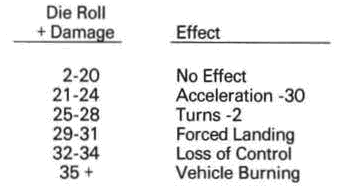
Explanation of Results
- ACCELERATION -30. The vehicle's engines were damaged, reducing its acceleration by 30 meters/ turn.
- TURNS -2. The vehicle's control and steering equipment was damaged, reducing the number of turns it can make per game turn by two.
- FORCED LANDING. The vehicle's fuel tank or parabattery was hit, leaving it with enough fuel to fly for 10 more minutes (100 turns). If the vehicle does not land within 10 minutes, it will crash.
- LOSS OF CONTROL. The cockpit was damaged by the attack. The pilot must pass a Reaction Speed check to keep the vehicle under control. If he fails the check, the vehicle immediately loses d100 meters of altitude. If the vehicle loses more altitude than it had, it crashes.
- VEHICLE BURNING. The vehicle is out of control and burning. It will crash in two turns. Characters can jump from the vehicle (see Movement: Jumping) or use a parawing. A parawing is a small, emergency glider, similar to a glijet with no rocket. A para wing will not work if the character was less than 10 meters above the ground when he jumped.
Crashing
Passengers in a vehicle that crashes suffer 1d10 points of damage for every 10 meters the vehicle fell, plus 1d10 points of damage for every 20 meters/turn it was traveling. This damage is doubled if the character is not strapped into a seat. When dividing the vehicle's altitude by 10 and speed by 20, round fractions down. If the vehicle is burning, the character suffers an additional 1d10 points of damage at the start of every turn he is in the vehicle. The crashed vehicle will not fly again without extensive repairs.
EXAMPLE: A jetcopter is traveling 75 meters above the ground at 30 meters/ turn when an attack damages the cockpit. The pilot fails his Reaction Speed check. so the copter drops d100 meters. The die roll is 83, meaning the vehicle drops 83 meters. This is more than its altitude, so it crashes. One passenger jumps using his parawing, but the pilot does not have one. When the copter hits the ground he suffers 7d10 damage because it fell 75 meters and another 1d10 because it was traveling 30 meters/ turn.
Other Vehicles
Many other means of transportation besides those described above are available in STAR FRONTIERS games. The systems and vehicles listed below will not be used in combat very often, but players may find ways to work them into their adventures.
Public Transportation
Monorails are the most common mass transit systems on Frontier worlds. Monorail cars can hold up to six passengers and travel at 70 to 100 meters/turn. Monorail passengers usually pay 1 CR per day for an unlimited number of rides. Occasionally, monorails are built underground and called subways.
Cabs of many types are common. Ground cars, skimmers and even cycles are used as cabs. Some are operated by drivers while others are piloted by robots or computers. A typical price is 2 Cr for the first km traveled and 1 Cr for each km after that.
Moving Walkways, also called people movers or sliders, are sidewalks that are built like conveyor belts. A person simply steps onto the slider and it carries him, her or it along at 10 meters/turn. Using a slider does not cost anything.
Flyers
Super -Sonic Transports, or SSTs, are large jet-powered aircraft capable of flying at very high altitudes at several times the speed of sound (sound travels 1,988 meters/turn). They are used as luxury passenger planes flying between large cities, as large cargo haulers supplying cities under construction, etc.
Orbital shuttles, often called orbiters, are a cross between an airplane and a space ship. They are powerful enough to fly into orbit around a planet, and sturdy enough to re-enter the atmosphere and land on the surface. They are commonly used to carry supplies and passengers to orbiting space stations and space ports. An orbiter can reach an orbiting space station in one to two hours.
Water Vehicles
Ships of many varieties are found throughout the Frontier. Players can find anything from three masted sailing ships to luxury liners and supertankers. Hovercraft are used commonly in areas where the sea is relatively calm. Skimmers can be used over water if the waves are not more than 40 cm high.
Submarines are used on worlds where the seas are very rough, covered with ice or otherwise unsuited to surface travel. They are common around underwater cities and sea-bottom mines.
Animals
Riding Animals and beasts of burden are used on many planets where the local technology is not advanced enough to build other vehicles. They also are used to get into areas that are too rough for ground vehicles, or where their natural abilities to sense water or danger are needed more than a vehicle's speed and reliability. |